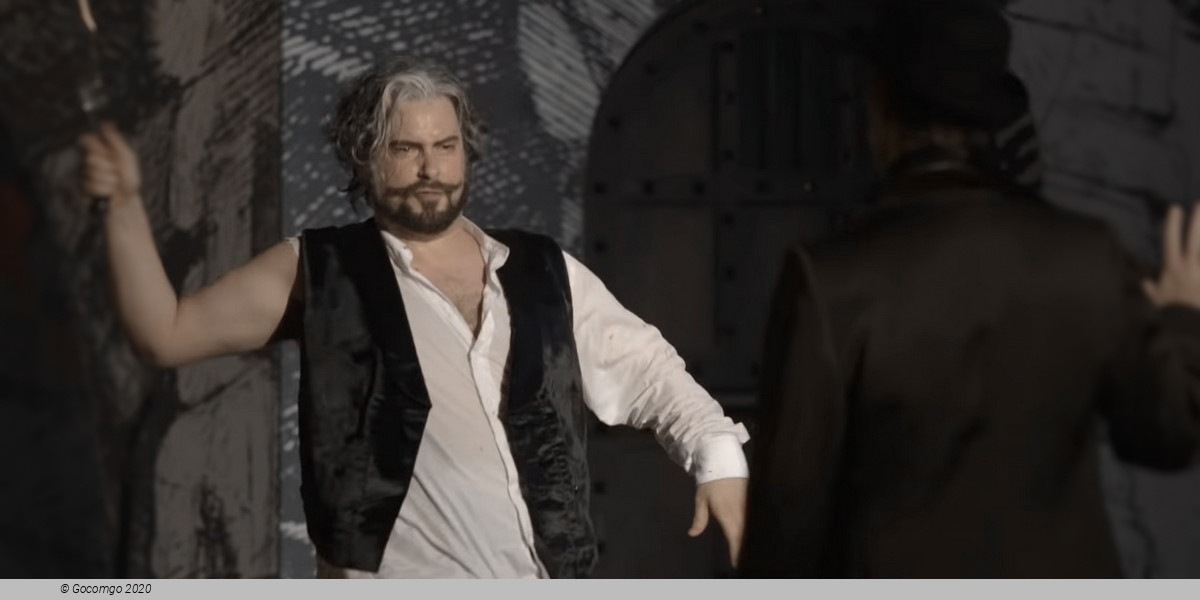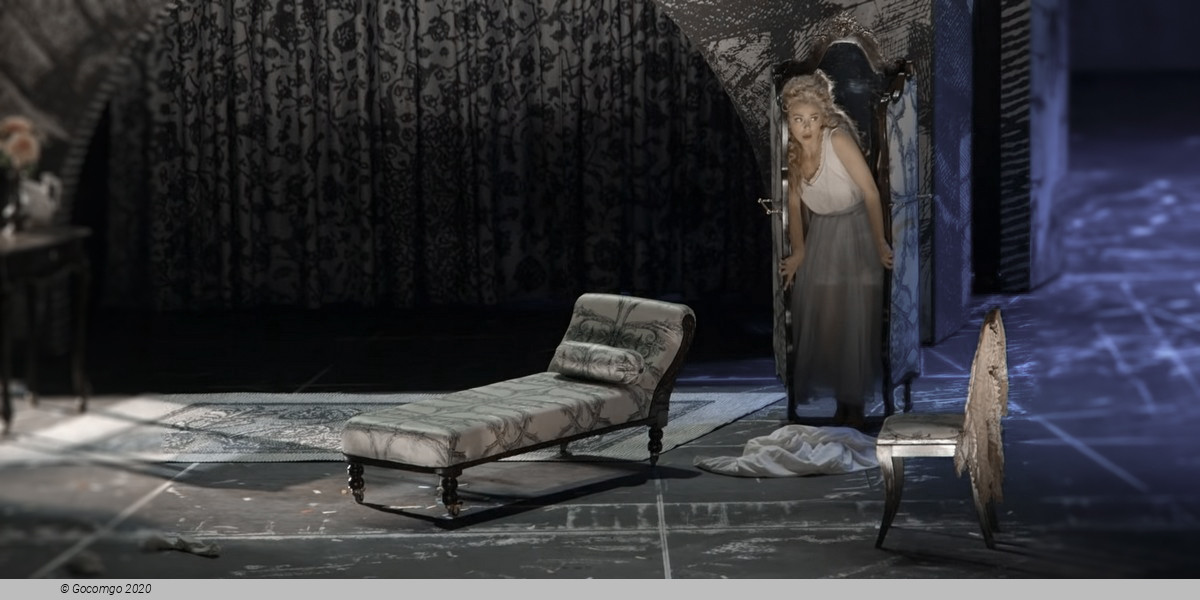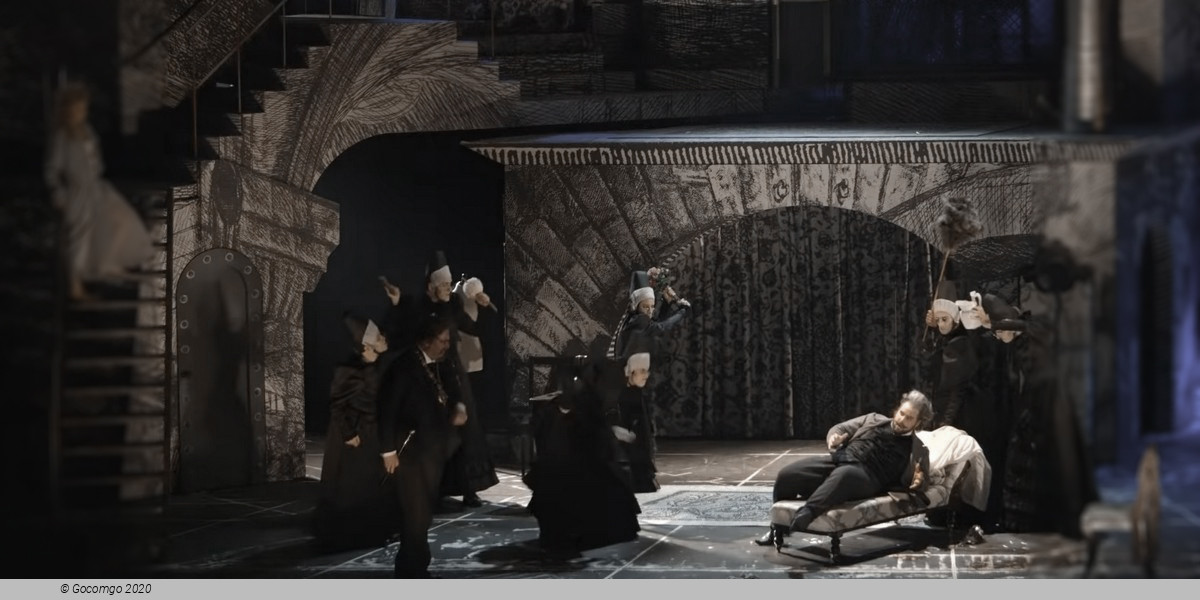Time: 1532
Place: Rome, during Carnival, over Shrove Monday, Mardi Gras, and Ash Wednesday.
Act 1
Tableau 1 (Balducci's residence)
Balducci has been summoned to a meeting with Pope Clement VII concerning the Pope's commission of a bronze statue of Perseus from the sculptor Benvenuto Cellini. Balducci would have preferred Fieramosca as the chosen sculptor; he also hopes to marry his daughter Teresa to Fieramosca. But Teresa is smitten with Cellini. Before Balducci goes to his meeting with the Pope, Cellini and other Carnival celebrators come on the scene, and pelt Balducci with fausses dragées (flour pellets) that make Balducci look "like a leopard". He can't clean himself off, however, so he continues to his meeting.
A bouquet of flowers comes through the window and lands at Teresa's feet. Attached is a note from Cellini saying that he is coming up. He does so, and explains his plan to take her away from her father so that they can live together. He and his assistant Ascanio will be disguised as monks, and will take her from her father during the Mardi Gras celebrations, when the Castel Sant'Angelo cannon is sounded to mark the end of Carnival. Unbeknownst to them both, Fieramosca has also entered the room, and tries to eavesdrop on them. He does not hear all the information on the first rendition, but he does on the second.
Upon hearing Balducci approach, Fieramosca hides in Teresa's bedroom, and Cellini hides behind the main room door. To distract her father, Teresa invents a story about a noise in her bedroom. Balducci goes into her bedroom, and Cellini escapes in the meantime. To Teresa's surprise, Balducci produces Fieramosca from the bedroom. He and Teresa call on the servants and neighbors to take Fieramosca and dump him outside in the fountain, but Fieramosca breaks free of the crowd.
Tableau 2 (Piazza Colonna)
Cellini, his apprentices and friends sing the praises of being goldsmiths. Bernardino asks for more wine, but the innkeeper demands settlement of their tab. Ascanio then appears with the Pope's advance payment for the Perseus statue, but also with a warning that the casting of the statue must occur the next day. The amount of money in the advance is less than expected, which gives new impetus to the plan to mock Balducci at Cassandro's booth that night.
Fieramosca has also overheard this plan, and confides to his friend Pompeo. Pompeo suggests that they too disguise themselves as monks and abduct Teresa themselves.
People gather in the piazza. A crowd assembles at Cassandro's booth, where "the pantomime-opera of King Midas or The Ass's Ears" is unfurled. Balducci and Teresa enter, soon after Cellini and Ascanio dressed as monks, and then Fieramosca and Pompeo similarly disguised. In the pantomime, Harlequin and Pierrot compete for the attention of King Midas, who is attired to look like Balducci. At this, the real Balducci approaches the stage, leaving Teresa alone. Both sets of "friars" then approach Teresa, to her confusion. The four friars begin to battle by sword, and in the struggle, Cellini fatally stabs Pompeo. The crowd becomes silent, and Cellini is arrested for murder. As he is about to be taken away, the three cannon shots from Castel Sant'Angelo are heard, indicating the end of Carnival and the start of Lent. All of the lights in the piazza are extinguished. During the darkness and resulting confusion, Cellini escapes his captors and Ascanio and Teresa go off. Fieramosca is then mistakenly arrested in Cellini's place.
Act 2
Tableau 1 (Ash Wednesday, Cellini's studio)
Ascanio and Teresa wait for Cellini in his studio. When a procession of friars passes by, they join in the prayer. Cellini then enters, still in monk's disguise, and recounts his escape. Because he is now wanted for murder, he plans to escape Rome with Teresa, but Ascanio reminds him of his obligation to cast the statue. Ascanio goes off to find a horse. Balducci and Fieramosca then appear. Balducci denounces Cellini as a murderer and then promises Teresa to Fieramosca in marriage.
The Pope then appears to check on the progress of the statue. Cellini makes excuses, but the Pope dismisses them and decides that he will give the commission to another sculptor. Cellini then threatens to destroy the mould, and when the Pope's guards approach him, he raises his hammer. The Pope then makes Cellini an offer: if Cellini can cast the statue that evening, he will forgive Cellini's crimes and let him marry Teresa. But if Cellini fails, he will be hanged.
Tableau 2 (Ash Wednesday, evening, Cellini's foundry)
After an aria from Teresa, Cellini comes on stage and muses on the quiet life of a shepherd. The workmen are at their labours and sing a sea-shanty, which Cellini sees as a bad omen. Ascanio and Cellini encourage the goldsmiths to continue their work. Fieramosca then arrives with two henchmen and challenges Cellini to a duel. Cellini accepts and asks to settle it on the spot, but Fieramosca prefers it to be done away from his workplace. Fieramosca and his men leave.
Teresa arrives and sees Ascanio hand Cellini his rapier, but Cellini assures her that he will be safe. Alone, she hears the workmen start to lay down their tools and stop work, as they have not been paid and lack direction from Cellini. She tries to assure them that they will be paid eventually, but to no avail. Fieramosca then appears, and Teresa faints, thinking that Cellini is dead. This is not so, as Fieramosca is about to offer a bribe to the goldsmiths to cease work completely. This turns the goldsmiths against Fieramosca and they reassert their loyalty to Cellini. Cellini then reappears, and he and the workmen force Fieramosca to don workclothes to help out.
In the evening, the Pope and Balducci arrive to see if the statue is completed. Fieramosca then announces that they are out of metal, which Francesco and Bernardino confirm. Balducci and Fieramosca are pleased at Cellini's impending failure. Cellini then prays, and in a moment of desperation, orders that all art works in his studio, of whatever metal, be put into the crucible and melted, to the consternation of Francesco and Bernardino. After this is done, an explosion blows the lid off the crucible. Then molten metal emerges to fill the mould, and the casting is successful. Balducci and Fieramosca acknowledge Cellini's success. The Pope pardons Cellini, and Cellini and Teresa are united. The opera closes with praise for the goldsmiths.






 Herbert-von-Karajan-Str. 1
Herbert-von-Karajan-Str. 1